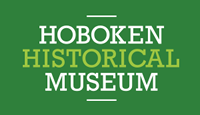Surveying the World: Keuffel & Esser + Hoboken, 1875–1968
January - December 2010

Hoboken’s Keuffel & Esser Made Instruments that Drove an Age of Progress
K&E, the initials carved into the roofline of the building at the corner of Third & Adams, are the only visible trace of a company that played a significant role in America’s phenomenal age of discovery and growth. Keuffel & Esser, a precision engineering instrument manufacturer that was based in Hoboken from 1875 to 1968, provided the tools that explorers and builders relied on for expeditions to the North Pole and across the American continents and for such engineering marvels as the Brooklyn Bridge and Panama Canal. It also created jobs for thousands of Hoboken residents, including many of the German immigrants who shared the heritage of the company’s founders, William J.D. Keuffel and Hermann Esser.
And anyone who remembers using a slide rule for complex calculations can thank K&E for popularizing the tool, its best-selling item among the thousands in its catalog. In over 90 years of operations in Hoboken, K&E’s rapid growth matched the expansion of the nation’s industrial base. It became the leading purveyor of tools and instruments used by engineers, surveyors, and the military, selling more than 10,000 items from nearly 300,000 square feet of office and factory space in Hoboken. Examples of many of these instruments will be on display in the Museum’s Main Gallery starting Sunday, Jan. 31 for Surveying the World: Keuffel & Esser + Hoboken, 1875 – 1968.
Visitors will be able to interact with some of the items on display, including slide rules, surveying instruments, lettering systems, and drafting tools. Descriptive plaques will describe how these tools were used in building railroads, farming, and exploration. One of the displays will explain a fascinating aspect of K&E’s Hoboken operations: A spider ranch! Read about how spider web filaments were used as crosshairs for telescopic sights, and the “Spider Lady,” Mary Pfeiffer, who ran K&E’s spider ranch from 1889 to World War II. The exhibit is made possible in part through a Special Project grant from the New Jersey Historical Commission, and the generosity of corporate sponsors: The Applied Companies, John Wiley & Sons, and Bijou Properties.
Keuffel and Esser opened their first office at 96 Nassau Street in New York City in 1867 to sell drawing materials and drafting tools, mostly imported from Europe. The company grew quickly and moved to larger quarters in Manhattan before leasing a small loft building at the southwest corner of Third and Adams in Hoboken in 1875. As their business expanded, they built a large, three-story structure at the northeast corner of Third and Adams in 1880, which was soon replaced with a massive building, covering most of Third St. between Grand and Adams Streets, in 1887.
By 1889, the partnership evolved into the Keuffel & Esser Company, which was privately held. After a fire in 1905 destroyed part of the Hoboken factory, the company constructed a fireproof concrete building on the west side of Adams, covering the full length of Third St. to Jefferson St. Opened in 1907, this nearly half-block-long building became the main offices for the company, until it closed in 1968 and moved to Morristown, N.J.
In 1975-76, the concrete “West” building became one of the first examples of adaptive re-use of an industrial building, known as The Clock Tower Apartments for its iconic four-sided clock, and joined the National Register of Historic Places in 1985. The “East” building was converted in 1984 to residential use.
